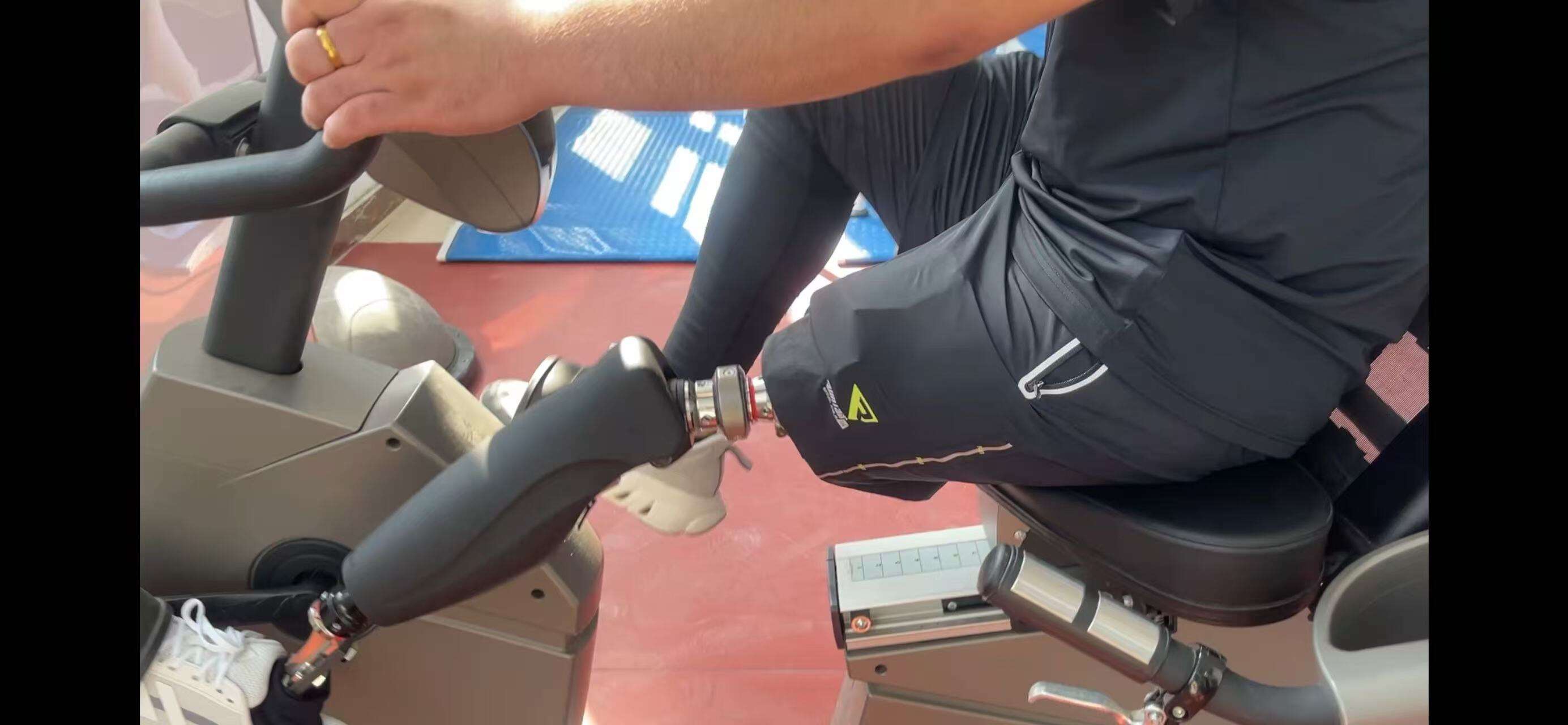Neural Control of Bionic Knee Joints Through Advanced Interfaces
How Neural Interfaces Enable Real-Time Communication Between the Bionic Knee Joint and the User's Nervous System
Neural interfaces are changing how we connect biology with machines, basically turning muscle electricity into actual movement for prosthetics. These fancy sensors inside bionic knees pick up when muscles contract through something called EMG technology. What does this mean for real people? They can tweak their steps, control how fast they walk, and react to different ground surfaces all within about 150 milliseconds. That's quicker than most folks realize because our eyes usually take longer to blink. Recent research out of MIT back in 2025 showed pretty impressive results too. People who lost limbs were able to avoid obstacles with around 92 percent success rate when using these new interfaces, whereas older socket type prosthetics only managed about 67 percent accuracy. Makes a big difference in daily life really.
Agonist-Antagonist Myoneural Interface (AMI) Surgery Improves Muscle Feedback and Movement Precision
AMI surgery works by reconnecting those paired muscle groups, which helps bring back the natural balance between muscles that work together and against each other. Patients report about 40% better feedback from their nerves after this procedure compared to regular amputation techniques. What does this mean practically? People can actually feel where their joints are positioned and how much resistance they're facing without thinking about it, something similar to what happens in normal knees. According to research appearing in Nature Medicine last year, folks who had the AMI treatment needed around 30 percent less adjustment when walking on bumpy ground. This makes long walks less tiring mentally since the brain doesn't have to constantly correct for every little stumble.
Clinical Performance of Bionic Knees Shows Enhanced Neural Integration and User Responsiveness
Research after implantation shows people with these advanced bionic knees can walk about 23 percent faster while burning around 18 percent less energy compared to traditional models. Most impressive perhaps is that nearly nine out of ten patients felt more connected to their prosthetics within half a year, thanks largely to the two-way communication happening between the device's sensors and nerve endings. When it comes to safety, there was a massive reduction too - folks fell down stairs almost 50% less often during testing periods. This kind of brain-machine synchronization really makes a difference when navigating everyday obstacles.
Microprocessor-Controlled Adaptation for Dynamic Movement and Gait Efficiency
Real-Time Gait Adaptation Algorithms Allow Bionic Knee Joints to Respond to Terrain Changes Seamlessly
Today's advanced bionic knee joints use smart processors powered by artificial intelligence to check out what's happening underfoot at a rate of about fifty times every second. When these devices sense changes in terrain like hills, steps, or rough ground, they tweak how stiff the joint feels, change how much it bends, and adjust the force needed to move forward. Research published in 2024 showed something pretty impressive too. People using these smart knees stumbled significantly less often on tricky surfaces compared to those with traditional mechanical prosthetics—in fact, about seventy two percent fewer trips! What makes all this possible is a clever mix of different technologies working together seamlessly behind the scenes.
- Inertial measurement units (IMUs) tracking 3D limb position
- Pressure sensors mapping ground contact forces
- Machine learning models predicting optimal gait patterns
Reduced Energy Expenditure and Improved Walking Efficiency Through Intelligent Motion Control
Clinical trials demonstrate microprocessor-controlled knees reduce metabolic energy costs by 18–22% during walking, due to optimized swing phase mechanics and stance phase energy recovery.
| Metric | Traditional Prosthesis | Microprocessor Knee |
|---|---|---|
| Energy Expenditure | 1.25 x body weight | 1.03 x body weight |
| Terrain Response Delay | 800–1200 ms | <200 ms |
| Movement Efficiency | 62% | 84% |
As shown in recent real-time motion control research, these systems dynamically redistribute kinetic energy during slope transitions, enabling natural cadence preservation across inclines up to 15°.
Osseointegration and Biomechanical Integration with Muscle and Bone
Direct Skeletal Attachment via Titanium Implants Eliminates Socket Discomfort and Enhances Force Transmission
Titanium implants work really well for direct bone anchoring because they have these special micromotion ranges between about 30 to 750 microns that actually help bones grow into them while keeping everything stable. Clinical tests show around 92 percent success rate with this kind of integration. What makes these implants stand out is how they completely get rid of those annoying pressure sores that come from regular sockets, plus they transfer forces much better too - about 37 percent improvement over traditional prosthetic options. The surfaces on these implants are engineered using some pretty advanced material biology concepts which means cells stick to them faster. Tests indicate this happens about 68 percent quicker than standard methods, and this ultimately leads to walking patterns that feel more natural for people who need these replacements.
Long-Term Durability of Integrated Bionic Knee Joints Supports Active, Unrestricted Mobility
Research over several years shows that about 85 percent of these integrated bone systems keep working properly even after five whole years of regular daily use. The reason? Titanium just doesn't wear out as fast, and when combined with how our bones naturally adjust themselves, it stops that annoying stress shielding effect. What does this mean practically? People can actually handle around 40% more weight when they run or jump compared to those old socket type implants. And get this: nearly 9 out of 10 users report no problems whatsoever with their joints when doing things like walking on uneven surfaces or light sports activities, which is pretty impressive if you ask me.
Enhanced Proprioception and User Embodiment for Functional Confidence
Restoring Natural Sensory Feedback Increases Psychological Acceptance and Motor Control
The latest bionic knee joints now come equipped with advanced neural interfaces that mimic the body's natural sensing abilities. These devices let users actually feel where their leg is positioned and how it moves thanks to built-in pressure sensors. Research from 2022 showed something pretty remarkable too. People who lost limbs and got these new prosthetics with real tactile feedback did about 40% better on balance tests than those with regular prosthetics. They also adapted much quicker to tricky surfaces, around 2.3 times faster according to the study results. What makes this so special? The way these interfaces work with the body cuts down on mental strain while walking. Clinical surveys back this up too, with nearly 8 out of 10 users saying they felt more connected to their artificial limb, which researchers call "limb ownership."
Improved Daily Mobility and Confidence in Amputees Using Responsive Bionic Knee Systems
Clinical trials using advanced bionic systems show users achieve 92% of natural gait symmetry during routine activities like stair climbing. Real-world testing highlights:
- 65% reduction in compensatory movements (e.g., hip hiking)
- 83% of users report reduced fear of falling on slippery surfaces
This enhanced reliability translates to a 27% increase in daily step counts among long-term users, per rehabilitation outcome metrics (2023).
Stability and Performance of Bionic Knee Joints in Challenging Environments
Adaptive joint resistance reduces fall risk during complex movements
Today's advanced bionic knees combine hydraulic dampers with smart learning systems that change resistance while moving around. These devices look at information coming from special pressure sensing insoles and motion tracking sensors built into the leg. When someone trips or hits an unexpected bump, the knee gets stiffer about half a second later to help maintain balance. Research published last year shows pretty impressive results too. People who lost their legs above the knee had 38 percent fewer falls when navigating tricky paths with these smart knees versus traditional prosthetics that don't adapt on their own.
Superior stair climbing, slope navigation, and obstacle avoidance in clinical testing
Models equipped with advanced microprocessors show real gains when put through their paces in actual field conditions. A recent 2025 study from MIT found that people using these new systems climbed stairs about 70 percent quicker than those with older hydraulic versions. They also made roughly 62% fewer mistakes walking over rocky ground covered in debris. The research team points to special sensors built into the devices as the main reason behind this improvement. These sensors can actually read what's coming next in the terrain, spotting changes in slope up to 200 milliseconds before someone's foot hits the ground. This early warning lets the system adjust power output just right so transitions from one surface to another happen smoothly without jarring stops or slips.
FAQ
What is a neural interface in the context of bionic knee joints?
Neural interfaces are advanced systems that enable communication between the bionic knee joint and the user's nervous system, allowing for real-time adjustments in movement based on muscle contractions detected through EMG technology.
How does AMI surgery improve the functionality of bionic knees?
Agonist-Antagonist Myoneural Interface (AMI) surgery reconnects muscle groups to enhance natural muscle feedback and movement precision, resulting in improved joint control and reduced need for manual adjustments.
What benefits do microprocessor-controlled bionic knees offer?
Microprocessor-controlled bionic knees provide adaptive movement by utilizing real-time algorithms and sensors to seamlessly adjust to terrain changes, improving safety and reducing energy expenditure during walking.
How does osseointegration enhance bionic knee prosthetics?
Osseointegration involves direct skeletal attachment using titanium implants, which eliminates socket-related discomfort and improves force transmission, leading to more natural movement and long-term durability.
What are the advantages of restored proprioception in bionic knees?
Restored proprioception using advanced neural interfaces enhances sensory feedback, increases psychological acceptance, and improves motor control, resulting in better balance and reduced mental strain during movement.
Table of Contents
-
Neural Control of Bionic Knee Joints Through Advanced Interfaces
- How Neural Interfaces Enable Real-Time Communication Between the Bionic Knee Joint and the User's Nervous System
- Agonist-Antagonist Myoneural Interface (AMI) Surgery Improves Muscle Feedback and Movement Precision
- Clinical Performance of Bionic Knees Shows Enhanced Neural Integration and User Responsiveness
- Microprocessor-Controlled Adaptation for Dynamic Movement and Gait Efficiency
- Osseointegration and Biomechanical Integration with Muscle and Bone
- Enhanced Proprioception and User Embodiment for Functional Confidence
- Stability and Performance of Bionic Knee Joints in Challenging Environments
-
FAQ
- What is a neural interface in the context of bionic knee joints?
- How does AMI surgery improve the functionality of bionic knees?
- What benefits do microprocessor-controlled bionic knees offer?
- How does osseointegration enhance bionic knee prosthetics?
- What are the advantages of restored proprioception in bionic knees?

